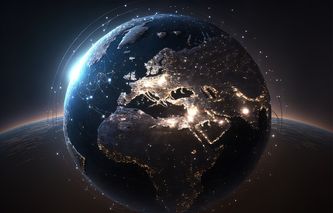We’ve heard a lot about the Dark Web in recent years — but how much do we really know about this mysterious part of the internet? In this overview of recent Dark Web statistics, we’ll start by examining the darknet in the context of the World Wide Web. The Moneyzine.com stats team will then look at the usage data for Tor, the go-to browser for accessing the Dark Web. Finally, we’ll focus on the notorious Dark Web marketplaces, explore their history, and review the latest prices of various illicit items.
Top 10 Dark Web Statistics and Facts for 2025
The Dark Web makes up an estimated 5% of the total internet.
Tor averaged more than 4.61 million daily users in Q3 of 2023.
Germans accounted for 52.56% of Tor’s direct daily users in Q3 of 2023.
29.61% of Tor’s bridge users in Q3 of 2023 connected from Russia.
Only 6.7% of Tor’s daily users engage in illegal activity on the Dark Web.
At least 500,000 users regularly visit Dark Web marketplaces.
With a 28% market share, BlackSprut is the largest Dark Web marketplace.
Hydra’s 2022 collapse led to an 89.4% drop in darknet market revenue.
As of Q1 of 2023, a forged Maltese passport cost $4,000 on the Dark Web.
Premium-quality malware sold on the Dark Web for $4,500 in Q1 of 2023.
General Dark Web Facts
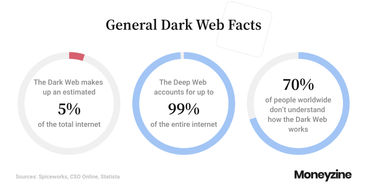
The Dark Web makes up an estimated 5% of the total internet.
As its contents are unindexed, it’s impossible to determine the Dark Web’s exact size. However, experts estimate it accounts for no more than 5% of the internet. In fact, the Dark Web is a small subset of a much larger Deep Web — a part of the internet containing all the pages hidden from search engines for privacy and security reasons. Meanwhile, the visible part of the internet all users can access is known as the Surface Web, and it hosts an estimated 19 terabytes of data.
The Deep Web accounts for up to 99% of the entire internet.
According to estimates, the size of this hidden web stands at 7,500 terabytes — making it about 400 times larger than the Surface Web. But illicit content takes up only a tiny fraction of that space. The vast majority of the Deep Web comprises perfectly legal content not meant for public consumption. This includes everything from academic papers and government documents to private, password-protected data like online banking, medical records, and email accounts.
70% of people worldwide don’t understand how the Dark Web works.
Despite being much talked about in recent years, darknet stats from a January 2023 survey reveal that 7 out of 10 people in select countries don’t understand what the Dark Web is or how it works. At 82%, Japan has the largest share of people unfamiliar with the concept of the Dark Web. Similar unfamiliarity levels were recorded in New Zealand (80%), France (73%), Australia (72%), and the United Kingdom (72%). Of the surveyed countries, Germany (65%), India (58%), and the United States (55%) had the smallest share of people unfamiliar with the Dark Web.
The history of the Dark Web dates back to the year 2000.
The internet itself started out as a private network before becoming publicly available. In that sense, the history of the Deep Web is as old as the history of the internet. But if we focus solely on the Dark Web, stats show its history dates back to 2000, when Ian Clarke released Freenet, his thesis project. A student at the University of Edinburgh, Clarke aimed to create a system of data storage and retrieval that would be decentralized, thus allowing for anonymous file sharing and communication. Only two years later, his thesis project would serve as the basis for the Tor Project, a non-profit group that launched the anonymous Tor browser in 2008.
Most internet users rely on the Tor browser to access the Dark Web.
The aforementioned Tor browser has established itself as the go-to browser for accessing the Dark Web. Though there are other browsers with similar functionality, Deep Web statistics point to Tor as the most popular — with 5.92 million new downloads worldwide in 2023’s third quarter.
Short for “The Onion Router,” Tor uses the decentralized onion routing network to allow users to browse the internet anonymously. Unlike VPNs, which also provide anonymity, it reroutes the users’ traffic through a network of nodes rather than just a single server. This way, Tor makes it much more difficult to trace the traffic back to the original user. Additionally, Tor enables users to access darknet sites hosted on .onion domains, something most common browsers can’t do.
Dark Web Usage Statistics for 2023
Tor averaged more than 4.61 million daily users in Q3 of 2023.
While it’s impossible to say precisely how many people regularly access the Deep Web and the Dark Web, looking at the number of Tor users could help paint a clearer picture. Between July 1 and September 30, 2023, this anonymous browser averaged over 4.61 million daily users, with more than 4.45 million connecting to it directly. During the same period, another 158,530 people connected to the browser via undisclosed servers. Also known as “bridges,” these secret relays allow people from countries with strict internet censorship laws to use the Tor browser safely.
Germans accounted for 52.56% of Tor’s direct daily users in Q3 of 2023.
Looking at the Dark Web numbers provided by Tor, the anonymous browser had approximately 2.34 million daily users during this period connecting from German IP addresses. Americans ranked second, accounting for 593,761 (13.33%) of Tor’s direct daily users. The top 10 for this period also includes users from India (2.19%), Finland (2.16%), Russia (1.82%), Indonesia (1.63%), Netherlands (1.46%), United Kingdom (1.45%), France (1.42%), and Iran (1.08%).
29.61% of Tor’s bridge users in Q3 of 2023 connected from Russia.
Back in 2021, Russians accounted for 14% of Tor’s direct daily users. But in December of that year, Russian authorities started blocking people’s access to Tor, describing it as a cover for illegal activities. Since then, local users have had to use bridges to connect to the browser.
Deep Web stats from 2023’s third quarter reveal that Iranians made up 24.44% of Tor’s bridge users, while people from the United States accounted for 15.08%. The top 10 for the period also included users from Germany (2.77%), Turkmenistan (2.39%), China (2.38%), France (1.83%), United Kingdom (1.77%), Netherlands (1.37%), and India (1.27% of Tor’s daily bridge users).
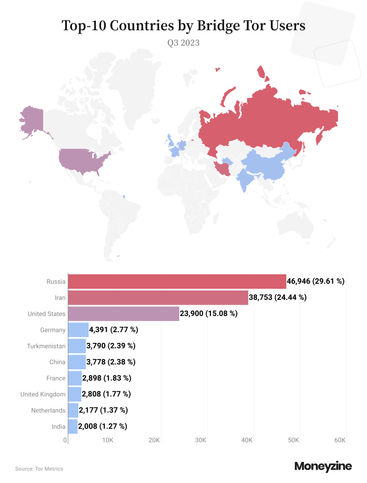
Pakistanis are most likely to look up the term “Dark Web” on Google.
Another way to gauge people’s interest in the Dark Web is to examine the percentage of those who look up the term “Dark Web” on Google. Between January 2019 and September 2023, the majority of those queries came from underdeveloped countries with well-documented instances of internet censorship. Pakistan topped the list with 100 index points (maximum), followed by Kenya (89 points) and Myanmar (87 points). The top 10 also included Bangladesh (78), Ethiopia (75), Nepal (75), Cameroon (67), Tanzania (66), Nigeria (65), and Sri Lanka (63 index points).
Globally, 12% of internet users have used Dark Web technologies.
According to the most recent survey on the use of technologies that enable access to the Dark and Deep Web, India had the highest percentage of users at 26%. Russia was second, with 22% of local netizens saying they have used tools like Tor to access the Deep Web. Brazil (21%), Indonesia (20%), Turkey (16%), South Africa (16%), and Sweden (16%) all made the top five. At 10%, the US ranked 11th — the same as Australia, Hong Kong, Germany, and Japan.
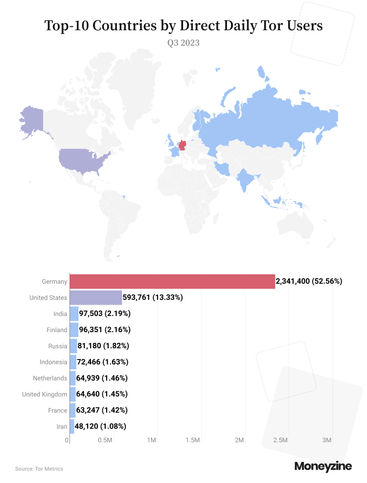
Only 6.7% of Tor’s daily users engage in illegal activity on the Dark Web.
A recent study found that only a tiny portion of Tor’s daily users connect to the Dark Web with the intent to engage in illicit activities. This suggests that most people use Tor to surf the internet anonymously. Interestingly, the percentage of users engaging in malicious activities is higher in countries with no internet restrictions (7.8% of Tor’s daily users) than in either those with some censorship (6.7%) or those where the government strictly limits people’s internet access (4.8%).
Scary Dark Web Marketplace Facts
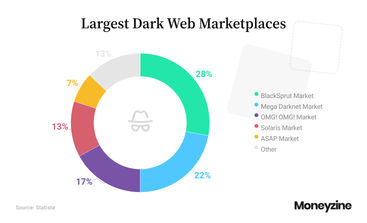
At least 500,000 users regularly visit Dark Web marketplaces.
Dark Web marketplaces are much like ecommerce websites on the Surface Web, but with one major difference — they mainly sell illicit and/or illegally obtained goods. These include stolen login credentials, credit card details, medical records, and cryptocurrencies. According to the latest available data, Dark Web marketplaces have at least half a million users with more than 2,400 sellers. In all, these marketplaces have recorded over 320,000 transactions, with more than 4,650 Bitcoin and 12,800 Monero — the go-to Dark Web cryptocurrency — transferred.
With a 28% market share, BlackSprut is the largest Dark Web marketplace.
BlackSprut placed first in a recent ranking of Dark Web marketplaces based on the amount of money deposited between January and November 2022. Known for drug trafficking and its alleged links to Russia, BlackSprut was the subject of a media controversy when several billboards for the marketplace were spotted in Moscow in early 2023. According to news reports at the time, it was unclear if these were paid ads or if the electronic billboards were hacked.
Other large markets include Mega (22%), OMG! OMG! (17%), Solaris (13%), and ASAP (7%).
Silk Road, the first major Dark Web marketplace, was shut down in 2013.
One of the most notorious Dark Web incidents occurred in October 2013, when the FBI shut down Silk Road, the then-largest Dark Web marketplace. Founded by Ross William Ulbricht in 2011, Silk Road quickly established itself as the go-to destination for illegal items, particularly illegal drugs. When the FBI arrested Ulbricht in 2013 for money laundering and drug trafficking, among other offenses, the criminal complaint revealed the marketplace had generated over $1.2 billion in just two years. Moreover, its operators had made another $80 million in commissions.
In May 2015, Ulbricht was sentenced to life in prison without parole. He was also ordered to pay restitution of $183 million — the estimated value of Silk Road’s drug and counterfeit ID sales.
The Russian-linked Hydra marketplace had a $1 billion turnover in 2020.
The story of Hydra is yet another in a series of creepy facts about the Dark Web. Back in 2020, this Russian-speaking marketplace was the world’s biggest darknet market. Worse yet, it was the largest marketplace for illegal drugs in all the countries of the former USSR. But much like its predecessor Silk Road, it didn’t last long. In April 2022, local authorities took down Hydra’s Germany-based servers and seized $25 million in Bitcoin. The investigation revealed that Hydra had more than 19,000 sellers and a total of 17 million customers during its two years of activity.
Hydra’s 2022 collapse led to an 89.4% drop in darknet market revenue.
Dark Web statistics show that all marketplaces had a combined daily revenue of $4.2 million shortly before Hydra was shut down in April 2022. Only days later, the remaining marketplaces managed a total of $447,000 — a staggering 89.4% decline. According to analysts, the market gradually recovered as the year progressed, with most Hydra sellers and buyers initially moving to the OMG! OMG! marketplace, which went on to dominate the market for 50 days. And while OMG! OMG! retained some of those new users, many soon migrated to BlackSprut and Mega.
In May 2023, Europol arrested 288 Dark Web vendors from nine countries.
Part of the operation to close the Monopoly marketplace, the arrests shed light on some scary facts about the Dark Web. Namely, during the operation, the authorities seized $53.4 million in cash and cryptocurrency, 117 firearms, and 850 kg (1,874 pounds) of illegal drugs. The drugs included 258 kg (568.8 pounds) of amphetamines, 43 kg (94.8 pounds) each of MDMA and cocaine, and another 10 kg (22 pounds) of LSD and ecstasy pills. The marketplace’s founder, a man with dual Croatian-Serbian citizenship, was previously arrested and extradited to the US.
Deep Web Market Prices in 2023
As of Q1 of 2023, a forged Maltese passport cost $4,000 on the Dark Web.
At that price, Maltese passports were the most expensive forged physical documents on darknet markets. French, Dutch, and select EU passports all cost $3,000 apiece, Polish passports went for $2,500 each, US passports sold for $2,000, while Lithuanian passports cost $1,800 each. Other popular physical documents included EU driver’s licenses ($2,000 apiece), EU national IDs ($1,700 on average), forged US green cards ($450), and IDs of several US states ($200).
Stolen credit card data cost no more than $110 apiece in Q1 of 2023.
Dark Web crime statistics show that the most expensive stolen credit card details with a $5,000 balance sold for just $110, and those with a balance of $1,000 cost $70 each. Hacked accounts on Card.com — popular issuer of prepaid VISA cards — went for $75 apiece, while stolen digital banking credentials with at least $2,000 available sold for $60. At the same time, hacked credit cards from countries other than the US sold for between $20 (e.g., Spain) and $35 (e.g., UAE).
In Q1 of 2023, verified crypto exchange accounts sold for as little as $70.
This was the price of a hacked account on the peer-to-peer exchange LocalBitcoins, which has since shut down. Unsurprisingly, facts about the Dark Web show that accounts on the more popular exchanges had higher asking prices. They ranged from $85 for a Blockchain.com account to $300 for a Crypto.com account to $1,170 for a Kraken account. Hacked and verified Wirex and N26 accounts commanded the highest prices — $2,300 and $2,650, respectively.
While stolen accounts across other categories saw year-over-year price drops, Deep Web facts reveal that crypto was up from 2022. That’s because digital currencies went stagnant between Q3 of 2022 and Q1 of 2023, resulting in less interest in buying crypto during this period. And since fewer people were investing in cryptocurrency, there were fewer new accounts to hack.
Premium-quality malware sold on the Dark Web for $4,500 in Q1 of 2023.
One of the many creepy Dark Web facts is that marketplaces don’t just sell forged and stolen documents and credentials — they also sell malicious software hackers can use to infect their targets. As of 2023’s first quarter, top-quality malware sold for $4,500 per 1,000 installations. High-quality malware with a slightly lower success rate went for $1,500–$1,600 (depending on the target region), and medium-quality malware with a 70% success rate sold for up to $700.
In Q1 of 2023, prices of DDoS attacks on the Dark Web ranged from $10 to $750.
Not only is the Dark Web’s DDoS market still active in 2023, but the prices of attacks are lower than ever. Ranging from $10 for an hour-long attack to $750 for a month-long attack, each with 10,000–15,000 requests per second, the prices depend on a variety of factors. Attacks with a smaller number of requests typically sell for less, and the target networks’ protection level also impacts the price. DDoS attacks remain a huge problem for companies and institutions around the world, especially as their frequency went up by 314% between H1 of 2022 and H2 of 2023.
Darknet and Deep Web Statistics: The Takeaway
Although it only constitutes a tiny part of the Deep Web and an even tinier part of the internet, the Dark Web is by no means insignificant. Millions of people regularly use Tor, which allows them to surf the Web anonymously, while also giving them access to the internet’s underbelly. The Dark Web is home to numerous marketplaces where hundreds of thousands of users can buy and sell everything from stolen login credentials and hacking tools to drugs and firearms.
But not everything is that terrifying, as Deep Web facts show that only 6.7% of Tor’s daily users engage in illegal activity on the Dark Web. The vast majority rely on the Deep Web and the Dark Web to provide them with freedom and anonymity while browsing the internet. More importantly, the darknet is a safe haven for people from countries with oppressive regimes, as it allows them to securely send and receive information and access content that is unavailable where they live.
.png)

.jpg)
